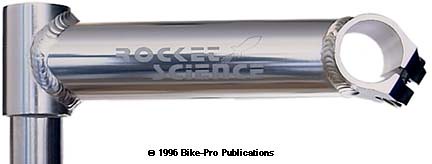Re: Rocket Science Components bling
The Rocket Science Zero-G stem combines epoxy composites with aluminum to yield a light weight enduring stem. The quill tube is internally re-inforced with a carbon fiber/epoxy composite which is said to reduce the weight of the quill tube. The wall thickness of the quill tube is 1.37mm, and is lined internally with another 1.37mm of the carbon composite. The quill tube is bonded to a vertical tube, amde of aluminum alloy, which is welde to the extension tube. This vertical tube has a 3mm wall thickness. The extension tube is round, with a 33.07mm outer diameter.
Rocket Science mentions in accompanying literature that the extension tube is cutom extruded for them to have a thicker top and bottom wall with narrower sides. If this were true, it would tend to add structure where needed while while minimizing excess weight. The binder tube also appeears to be an extrusion, that has the front milled so there is a protusion which will house the binder bolt. The hole bored from the top leaves a cradle for the binder bolt head and a pass through for the bolt shank. The lower side of the binder assembly is also bored, in this case its to make a hole for a stainless steel nutsert which is pressed in from the bottom for the binder bolt to anchor into.
The binder tube and the vertical tube at the rear have a hole drilled through one side to relieve heat at time of welding. The vertical, extension and binder tubes are TIG welded using a contiuous welds that begins on the bottom of the stem. The binder bolt is made of cadmium plated steel having 6mm x 1mm pitched threads. It's 16mm long with a 5mm hex head and weighs 5.5 grams. The expander bolt passes through a 4.5mm thick disc of aluminum. The disc lies on top of the quill tube within the vertical tube to support the expander bolt head, while it remains recessed in the vertical tube. The expander bolt is made of steel, with 8mm x 1.25mm pitched threads, is 130mm long with a 6mm hex fitting and weighs 54 grams.
The wedge Rocket Science chose to use is the Brodie cast magnesium wedge which weighs 9 1/2 grams (rather than the 14 gram average). This 63.5 gram weight is up slightly from the 61.5 grams of the bolt and wedge used the first year of Zero G production. In the first year, the bolt was only 110mm long weighing 46.5 grams and a machined from rod wedge weighed 15 grams. The longer bolt is necessary becase of the shape the Brodie wedge is cast in. The vertical tube and bolt are closed off witha Black plastic press-in cap. The sides of the extesion tube are etched with the Rocket Science logo.
The Zero-G comes in three diameters, 1", 1 1/8", or 1 1/4" in three lengths 120mm, 135mm, or 150mm. It is made in a 0 degree or a 10 degree rise and anodized in three colors, Black, Lavender, or Silver. The weight of the Zero G in a 10 degree rise , 1" diameter, 135mm is 230.5 grams, a 0 degree, 1" diameter with 150mm length is 240 grams.
[url
 G-zero stem
G-zero stem by
Wholly Spokes, on Flickr][/url]
BikePro,com
